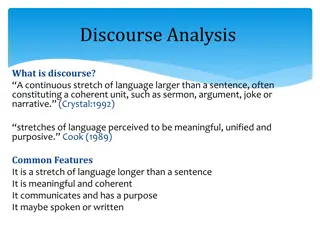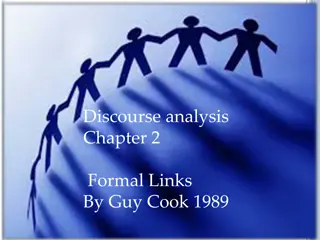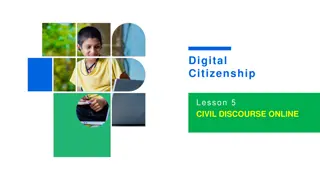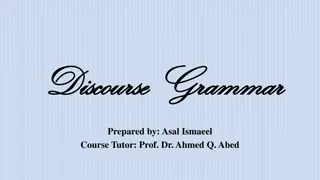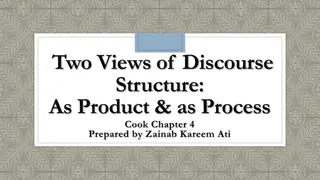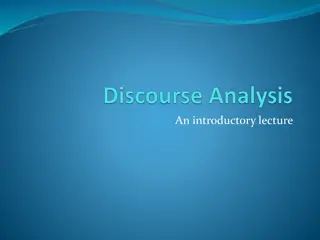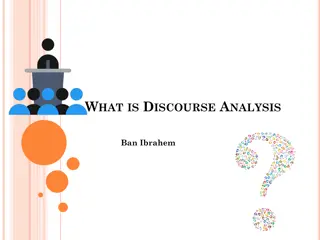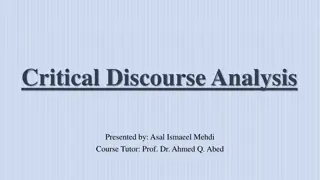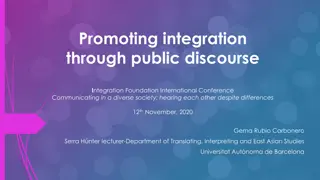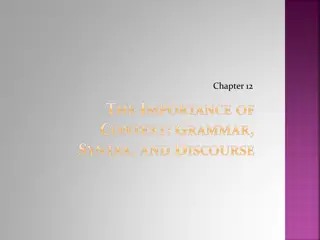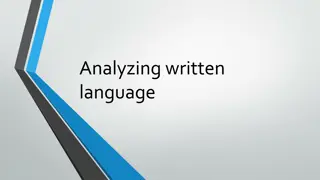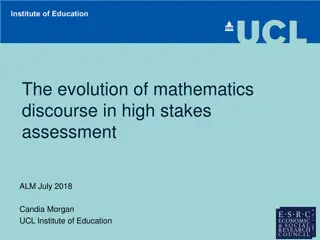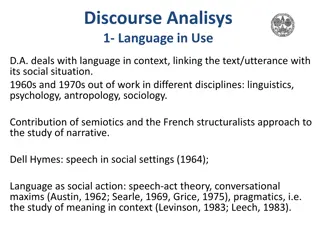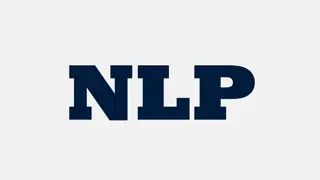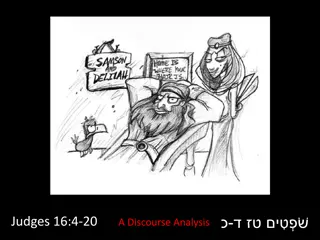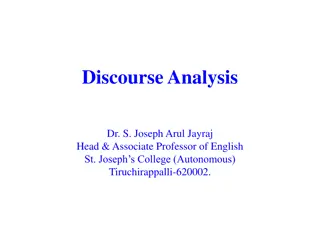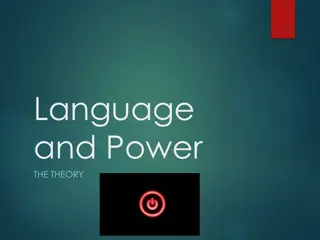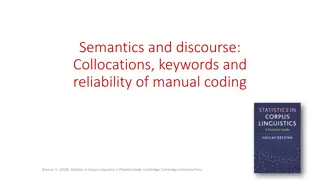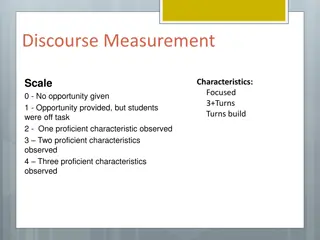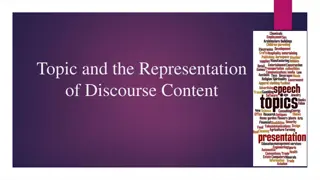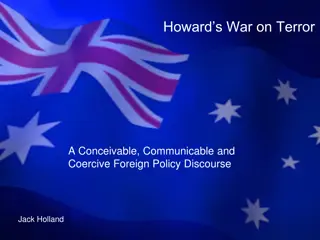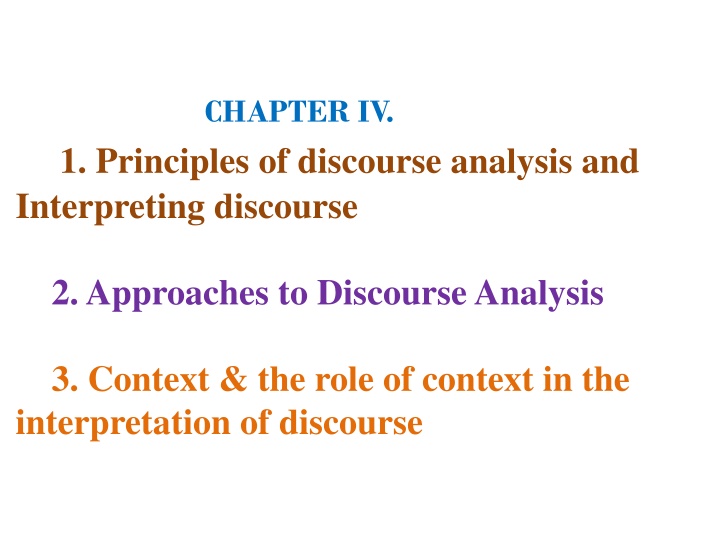
Principles and Approaches to Discourse Analysis
Explore the principles and approaches involved in discourse analysis, focusing on how language functions in various contexts and its social implications. Learn about analyzing discourse on multiple levels and the steps to conduct effective discourse analysis.
Uploaded on | 0 Views
Download Presentation

Please find below an Image/Link to download the presentation.
The content on the website is provided AS IS for your information and personal use only. It may not be sold, licensed, or shared on other websites without obtaining consent from the author. If you encounter any issues during the download, it is possible that the publisher has removed the file from their server.
You are allowed to download the files provided on this website for personal or commercial use, subject to the condition that they are used lawfully. All files are the property of their respective owners.
The content on the website is provided AS IS for your information and personal use only. It may not be sold, licensed, or shared on other websites without obtaining consent from the author.
E N D
Presentation Transcript
CHAPTER IV. 1. Principles of discourse analysis and Interpreting discourse 2. Approaches to Discourse Analysis 3. Context & the role of context in the interpretation of discourse
1. Principles of discourse analysis and interpreting discourse DiscourseAnalysis: Aresearch method for studying written or spoken language in relation to its social context. > It aims to understand how language is used in real life situations.
Some principles of discourse analysis 1. Conducting discourse analysis must focus on: + The purposes & effects of different types of language; + Cultural rules & conventions in communication; + How values, beliefs & assumptions are communicated; + How language use relates to its social, political & historical context 2. Using qualitative research method in humanities & social science disciplines, including linguistics, sociology, anthropology, psychology & cultural studies.
3. In conducting discourse analysis must examine how language functions & how meaning is created in different social contexts. It can be applied to any instance of written or oral language, as well as non-verbal aspects of communication such as tone & gestures. 4. Emphasizing the contextual meaning of language; Focusing on the social aspects of communication & the ways people use language to achieve specific effects (e.g. to build trust, to create doubt, to evoke emotions, or to manage conflict).
5. Analyzing discourse on multiple levels since discourse analysis is used to study larger chunks of language, such as entire conversations, texts, or collections of texts: Level of communication, Vocabulary, Grammar, Structure, Genre, Non-verbal.
6.Following 4 steps: Step 1: Define the research question & select the content of analysis To do discourse analysis, begin with a clearly defined research question; developing the question, selecting a range of material that is appropriate to answer it. Step 2: Gather information & theory on the context Must establish the social & historical context in which the material was produced & intended to be received. (Gathering factual details of when & where the content was created, who the author is, who published it, & whom it was disseminated to.) Conduct a literature review on the topic & construct a theoretical framework to guide the analysis.
Step 3:Analyze the content for themes & patterns Examining various elements of the material: words, sentences, paragraphs, & overall structure, & relating them to attributes, themes, & patterns relevant to your research question. Step 4: Review your results & draw conclusions Having assigned particular attributes to elements of the material, reflect on the results to examine the function & meaning of the language used; Considering the analysis in relation to the broader context that was established earlier to draw conclusions that answer the research question.
2. Approaches to discourse analysis. According to Sara Mills in Discourse, Routledge, London and New York, 1997, Introduction, there are 3 main approaches to discourse analysis. She introduces thought & theoretical perspectives in the study of discourse analysis.
1. Linguistic approach. According to F.de Saussurethe: The nature of language as a stationary, closed system; distintion of language & speech. + Language is a system, an abstract mental structure, in general, while speech is the manipulation of language in specific situations, by specific individuals; + Language is a social substance, belonging to the community while speech belongs to the individual. + Languages are a priori & immutable constructs while speech is the generative plane. > The object of research in linguistics is language, a product of society that accumulates in each person's brain, not utterances.
> Distintion between discourse & text: text - a static linguistic structure, & discourse - a dynamic speech structure. > Discourse analysis focuses on the structure of spoken language that occurs naturally in discourses such as dialogue, interviews, commentary, & speech. Text analysis focuses on the structures of written language, in texts such as essays, notices, road signs, & book chapters.
* Discourse analysis: a methodological approach to language analysis above the sentence level, including criteria: connectivity, reflection, etc.; * Discourse analysis is approach to oral & written linguistic documents on the sentence (discourse/text) from its realistic multifaceted, including linguistic aspects & situational contexts, with relevant aspects expressed in the concept of the domain with very rich & diverse content; * Discourse analysis aims to highlight the close relationship between the linguistic structure inside the text & the elements outside the text.
The linguistic approach is based on structuralism: focusing on discovering the static, invariable structure of discourses & texts.
2. The Genre/ Stylistic approach Bakhtin's views: the genre/stylistic approach to discourse analysis is developed on the basis of opposition to Saussure's views on language: attention to language in life, in communication, the field of communication. * The study of "the life of speech", "the flow of words", in other words, language as a diverse, living, historical entity rather than a historical entity; language is not a closed & abstract system.
* Discourse is a language in a living whole, specifically, a language in use, in a social context. * Discourse is the common territory of the speaker & the listener, the area of contact between us & the other. * Studying linguistic genre through discourse: the limitless & ever-changing variety of linguistic genres of speech in practice & in history. * Complicated discourse genres: novels, plays, political treatises, science, etc.
Thus, if the utterance has bold personal nuances, expressing the styles of different speaking subjects, then the discourse genre represents the linguistic style of each era, with community & social character, which precedes & governs the utterances of individuals. > Language study: the study of discourse in communication, in diverse & vivid real life.
3. Sociological approach M. Foucault's conception of discourse: First, discourse is considered to be all statements in general; all utterances or texts that have some meaning & effect in the real world. Second, discourse - a group of specific discourses, conventionally defined in some way & having a general coherence or effect, "grouped together by some institutional pressure".
Third, discourse - a practice that generates a multitude of statements & governs their operation, the rules & structures that produce particular utterances & texts: a system of "thoughts, opinions, concepts, ways of thinking & behaving, which are formed in a particular social context", which have a general effect on the way of thinking & speech of each group of people as well as of each individual.
Discourses strongly influenced by institutions & powers. People's utterances & thoughts are not the free expression of individual thoughts, but are shaped& locked into a pre-existing framework. Example. The discourse on femininity, which was produced & circulated in medieval Vietnam, is a system of ideas, concepts,& norms of behavior formed in the context of the feudal state institution of masculinity: femininity as is humility, endurance, dependence, weakness (compassion & four virtues), in any text one finds a familiar formula for describing women: praising the virtues, sacrifice, tolerance, dependence...
According to Foucault: both knowledge & power can only be created, realized, operated & distributed by & in the discourse: Power, being "the constitutive condition of all speech", which not only forbids people to speak but also allows people to speak; Knowledge - the product created by discourses; the set of general discursive structures within which a culture defines its ideas
Sub-conclusion These 3 linguistic, genre/stylistic & sociological approaches have provided three different definitions of discourse: discourse as the structure of language/speech, & discourse as speech-thoughts, ideology, & discourse as tools for knowledge construction & the exercise of power. These 3 conceptions arise on the basis of different interpretations of the nature & role of language. These 3 approaches are pervasive & greatly influenced almost all literary & linguistic theory in the 20th century. In fact, in the process of development, discourse theories tend to intertwine, creating areas of interference, common areas. Since the mid-1990s, a new branch of discourse research has emerged: Critical discourse analysis proposed (Fairclough).
CONTEXT * In semiotics, linguistics, sociology & anthropology, context refers to those objects or entities which surround a focal event. * In a communicative event Context is "a frame that surrounds the event & provides resources for its appropriate interpretation".
FEATURES OF CONTEXT Context embraces the following categories: * The relevant features of participants: persons & personalities (verbal/oral action or non-verbal action of participants). * The relevant of objects * The effect of the verbal action
Dell Hathaway Hymes (June 7, 1927, Virginia, USA)- a linguist, sociolinguist, anthropologist & folklorist who established disciplinary foundations for the comparative, ethnographic study of language use.
Hymes identifies the following listing of context features: Addressor (speaker or writer) & addressee (hearer or listener/decoder of utterance); Audience (unintended addressees); Topic (range of language); Setting (place, time, posture, gesture, facial expression; Channel (how the contact between participants: speech, writing, signing, signal); Code (kind of language, style of language); Message-form (chat, debate, sermon, fairytale, love letter, lecture, radio talk, play ); Event (nature of communication, genre: opening speech, welcoming speech, papers); Key (evaluation); Purpose (outcome the participant want to happen).
Exercise: Analyze the following extract in terms of the features of context to the extent possible Mr. President, Mr. Speaker, Members of the House and the Senate, Distinguished Americans here as visitors in this Chamber as I might, It s nice to have a fresh excuse for giving a long speech. When presidents speak to the Congress and the nation from this podium, typically they comment on the changes and the opportunities that face the United States, but this is not an ordinary time for all the many tasks that require our attention. I believe tonight one calls on us to unite and to act, that s our economy
CO-CONTEXT Co-context: The words surrounding a particular word or passage within a text that provide context & help to determine meaning (the stretch of language occuring before or after the utterance needs to be interpreted) Ex. The same evening I went ashore. The first landing in any new country is very interesting. (landing is specific meaning determined because of the previous discourse. The person went ashore, travelled by ship, not by bus or plane.)
Principle of Local interpretation The extend of the context within which the hearer will interpret where they are (speaker & hearer)/the local setting. Ex. A man & a woman sitting in the living room the man s bored, goes to the window, looks out the window and goes out to a club, has a drink, talks to the barman. > (Hearer assumes that the entities(man &woman) will remain & local setting will stay constant. The hearer interpreted that the window is of & in the living room, the club is near to the living room)
PRINCIPLE OF ANALOGY An Analogy is a relation of similarity between two or more things, so that an inference (reasoning from premise to conclusion) is drawn on the basis of that similarity.
The principle of analogy enables the hearer or listener to interpret discourse in light of his past experience & background knowledge. > When the hearer encounters a new situation he selects from his memory a type of experience he has generalized before & relates it to his background knowledge in order to interpret >> Analogy with previous similar discourse.
SUMMARY * The distinction between context & co-text: Co- text restricted to the linguistic factors; Context refers to those that are outside language. * Features of context (by Hypes) * The 2 principles of Local interpretation & Analogy
Revision of chapter IV 1. Present the principles of discourse analysis 2. Present 4 steps to interpret discourse 3. Present 3 approaches to discourse analysis: Linguistic, Genre and Sociological


